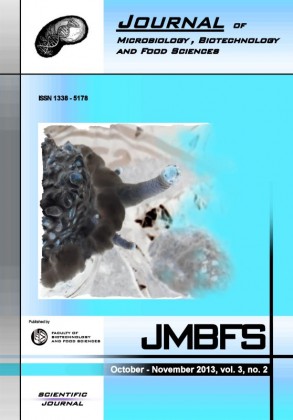RESPONSE SURFACE METHODOLOGY APPROACH FOR OPTIMIZATION OF FLAX SEED OIL BLEACHING PROCESS
Keywords:
Flax seed oil, bleaching, RSM optimization, acid value, peroxide valueAbstract
Flax seed is an important source of omega-3 polyunsaturated fatty acids essential for human physiology. For low oxidation stability, specific taste and concomitant color compounds this oil is poorly applicable as nutraceutical additive. The aim of this study was optimization of flax seed oil bleaching. The optimal conditions for the bleaching process were determined using response surface methodology. A central composite design was used to investigate the effects of three independent variables, namely solid to liquid ratio, temperature and time, to output parameters of the bleaching process such as crude oil color expressed as optical density at 490 nm, acid and peroxide value. Calculated optimal conditions for the bleaching, expressed by the optical density of the oil were as follows: temperature 50°C, bleaching time 77 minutes and solid-liquid ratio 56 g of bleaching agent to 1 liter of oil.Downloads
Download data is not yet available.
Downloads
Published
2013-10-01
How to Cite
OndrejoviÄ, M., Chmelová, D., & Maliar, T. (2013). RESPONSE SURFACE METHODOLOGY APPROACH FOR OPTIMIZATION OF FLAX SEED OIL BLEACHING PROCESS . Journal of Microbiology, Biotechnology and Food Sciences, 3(2), 101–104. Retrieved from https://office2.jmbfs.org/index.php/JMBFS/article/view/7049
Issue
Section
Food Sciences
License
Copyright (c) 2013 Miroslav OndrejoviÄ, Daniela Chmelová, Tibor Maliar

This work is licensed under a Creative Commons Attribution 4.0 International License.
All papers published in the Journal of Microbiology, Biotechnology and Food Sciences are published under a CC-BY licence (CC-BY 4.0). Published materials can be shared (copy and redistribute the material in any medium or format) and adapted (remix, transform, and build upon the material for any purpose, even commercially) with specifying the author(s).

